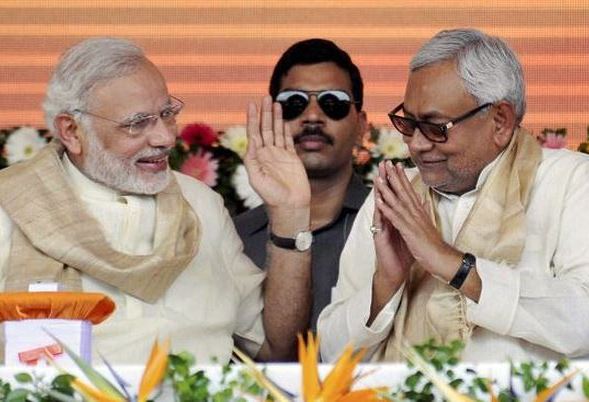Ever since the two parties joined hands over 20 years ago, the Bharatiya Janata Party has played second fiddle to the Nitish Kumar-led Janata Dal (U) in Bihar. The saffron party depended on Nitish Kumar’s clean image and charisma to ride to power in the eastern state where it had negligible presence.
As Bihar prepares for its next round of assembly elections now, there’s a perceptible change in the equation between the two parties. With Nitish Kumar facing massive anti-incumbency after 15 years in power and Prime Minister Narendra Modi’s popularity at an all-time high, the tables have turned in favour of the BJP. Today, it is the Janata Dal (U) chief who needs the BJP to retain power.
Well aware that it is on a strong footing this time, the BJP is all set to drive a hard bargain with the Janata Dal (U) during its seat-sharing negotiations to be able to emerge as the single largest party post-polls which would open up the possibility of the saffron party laying claim to the chief minister’s post. On the face of it, Prime Minister Narendra Modi and BJP president J.P.Nadda have publicly declared that the coming assembly polls will be fought under Nitish Kumar’s leadership. The reason for this is obvious. The BJP obviously does not wish to alienate the Janata Dal (U) chief and push him to the rival camp.
But the BJP is also in no mood to concede the upper hand to its alliance partner. The saffron party has, over the years, used the Janata Dal (U) to expand its footprint in Bihar and it believes it is now in a position to emerge as the dominant force in the state. The saffron party’s Bihar unit has, therefore, been urging its Central leaders for several months now that the BJP should make a strong pitch for the top executive post in the state, especially since Nitish Kumar is personally on shaky ground. The BJP hardliners have been at pains to point out that the ground situation in Bihar has undergone a sea change and with the BJP’s improved presence it can dictate terms to its alliance partner.
ALSO READ: Political Milking Of Sushant’s Death
For the first time in his ruling terms, Nitish Kumar is facing mounting public anger. His government’s handling of the coronavirus pandemic, the migrant labour crisis, rising unemployment, rampant corruption and the damage wrought by the recent floods have all combined to push Nitish Kumar on the backfoot. It is to deflect attention from his government’s failures that the Bihar chief minister, with dollops of help from the BJP, has shifted the political discourse to the Sushant Singh Rajput case, currently being probed by the Central Bureau of Investigation. The dates for the election are yet to be announced but the state is already dotted with posters of the actor with the caption “Na bhoole hain, no bhoolne denge”, a clear indication of how the poll campaign will pan out in the days ahead.
Even as Nitish Kumar is fighting with his back to the wall, he has to deal with another irritant. An ally – Lok Janshakti Party’s Chirag Paswan – has launched an offensive against the Bihar chief minister. Paswan junior has, in recent weeks, taken several potshots at Nitish Kumar and has even threatened to contest the Bihar assembly poll on his own.
As the anchor of the National Democratic Alliance, it would be expected that the BJP would step in to silence the LJP leader. But it has made no serious move in that direction. This has given rise to speculation that Paswan junior is acting on the behest of the saffron party. It is understood that his barbs are essentially aimed at garnering a larger share of seats for his party, which works to the BJP’s advantage. If the share of Janata Dal (U) seats is reduced and the BJP contests on more seats, it stands a greater chance of emerging as the single largest party.
ALSO READ: Grumblings In The NDA Camp
While Nitish Kumar finds himself in the doghouse, the Modi magic remains undiminished. Despite the Centre’s poor handling of the coronavirus pandemic, the slump in the economy and the standoff with China, people in Bihar, as elsewhere in the country, are not ready to blame the Modi government for the multiple crises facing the country. They are willing to overlook the Centre’s failures and even justify them on the ground that these problems are not confined to India but are a worldwide phenomenon. Modi’s image of a Hindu Hirday Samrat and the BJP’s majoritarian agenda is more than sufficient reason for them to support him and the saffron party.
If the BJP-Janata Dal (U) combine comes back to power (as it is expected to), the victory will be driven by Modi’s popularity and not Nitish Kumar’s governance record. The ruling coalition will additionally be helped by the disarray in the opposition camp and its inability to throw up a viable alternative. While the Congress has negligible presence in the state. Rashtriya Janata Dal leader Lalu Prasad Yadav is out of action and his son Tejaswi Yadav is yet to evolve into a mature politician.
Even as the opposition is still debating the terms of building a coalition of like-minded parties, the BJP has already kickstarted its campaign with virtual rallies and is in the process of strengthening its digital infrastructure to connect with the voters. Since there are restrictions on physical campaigning in this election because of the coronavirus pandemic, the BJP has decided to maximise the use of social media and other digital platforms to inform the people about their government’s achievements.
The opposition just does not have the resources, the leadership and the organisation to match the BJP.
